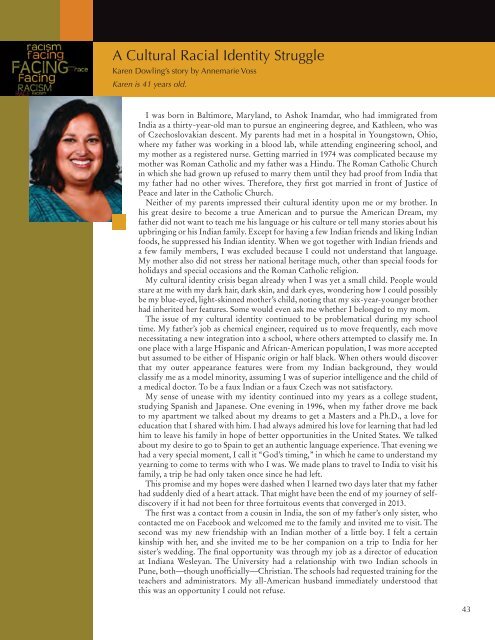FacingRacismLR
Create successful ePaper yourself
Turn your PDF publications into a flip-book with our unique Google optimized e-Paper software.
A Cultural Racial Identity Struggle<br />
Karen Dowling’s story by Annemarie Voss<br />
Karen is 41 years old.<br />
I was born in Baltimore, Maryland, to Ashok Inamdar, who had immigrated from<br />
India as a thirty-year-old man to pursue an engineering degree, and Kathleen, who was<br />
of Czechoslovakian descent. My parents had met in a hospital in Youngstown, Ohio,<br />
where my father was working in a blood lab, while attending engineering school, and<br />
my mother as a registered nurse. Getting married in 1974 was complicated because my<br />
mother was Roman Catholic and my father was a Hindu. The Roman Catholic Church<br />
in which she had grown up refused to marry them until they had proof from India that<br />
my father had no other wives. Therefore, they first got married in front of Justice of<br />
Peace and later in the Catholic Church.<br />
Neither of my parents impressed their cultural identity upon me or my brother. In<br />
his great desire to become a true American and to pursue the American Dream, my<br />
father did not want to teach me his language or his culture or tell many stories about his<br />
upbringing or his Indian family. Except for having a few Indian friends and liking Indian<br />
foods, he suppressed his Indian identity. When we got together with Indian friends and<br />
a few family members, I was excluded because I could not understand that language.<br />
My mother also did not stress her national heritage much, other than special foods for<br />
holidays and special occasions and the Roman Catholic religion.<br />
My cultural identity crisis began already when I was yet a small child. People would<br />
stare at me with my dark hair, dark skin, and dark eyes, wondering how I could possibly<br />
be my blue-eyed, light-skinned mother’s child, noting that my six-year-younger brother<br />
had inherited her features. Some would even ask me whether I belonged to my mom.<br />
The issue of my cultural identity continued to be problematical during my school<br />
time. My father’s job as chemical engineer, required us to move frequently, each move<br />
necessitating a new integration into a school, where others attempted to classify me. In<br />
one place with a large Hispanic and African-American population, I was more accepted<br />
but assumed to be either of Hispanic origin or half black. When others would discover<br />
that my outer appearance features were from my Indian background, they would<br />
classify me as a model minority, assuming I was of superior intelligence and the child of<br />
a medical doctor. To be a faux Indian or a faux Czech was not satisfactory.<br />
My sense of unease with my identity continued into my years as a college student,<br />
studying Spanish and Japanese. One evening in 1996, when my father drove me back<br />
to my apartment we talked about my dreams to get a Masters and a Ph.D., a love for<br />
education that I shared with him. I had always admired his love for learning that had led<br />
him to leave his family in hope of better opportunities in the United States. We talked<br />
about my desire to go to Spain to get an authentic language experience. That evening we<br />
had a very special moment, I call it “God’s timing,” in which he came to understand my<br />
yearning to come to terms with who I was. We made plans to travel to India to visit his<br />
family, a trip he had only taken once since he had left.<br />
This promise and my hopes were dashed when I learned two days later that my father<br />
had suddenly died of a heart attack. That might have been the end of my journey of selfdiscovery<br />
if it had not been for three fortuitous events that converged in 2013.<br />
The first was a contact from a cousin in India, the son of my father’s only sister, who<br />
contacted me on Facebook and welcomed me to the family and invited me to visit. The<br />
second was my new friendship with an Indian mother of a little boy. I felt a certain<br />
kinship with her, and she invited me to be her companion on a trip to India for her<br />
sister’s wedding. The final opportunity was through my job as a director of education<br />
at Indiana Wesleyan. The University had a relationship with two Indian schools in<br />
Pune, both—though unofficially—Christian. The schools had requested training for the<br />
teachers and administrators. My all-American husband immediately understood that<br />
this was an opportunity I could not refuse.<br />
43


